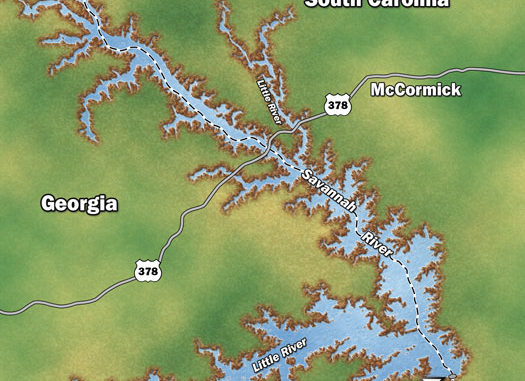
September brings unique challenges and opportunities for striped bass fishermen on Clarks Hill Lake.
The bad news about September on Clarks Hill is that the water is warm — borderline hot — which makes tough customers out of cool-loving striped bass.
The good news is that tough conditions tend to force fish into specific areas of tolerable habitat, in essence “shortening the playing field.” That’s valuable because Clarks Hill (officially J. Storm Thurmond Reservoir) makes for a very big playing field. In fact, at 71,545 acres, it is the second-largest reservoir east of the Mississippi River.
During mid-summer, the habitat gets squeezed for striped bass, especially large ones, and by September, most fish will normally be in the deeper, lower end of the lake, holding at or near the thermocline, where both water temperatures and dissolved oxygen levels tend to be at least tolerable. Last year, the available habitat got so limited at one point that several large stripers died.
Clarks Hill, the furthest downstream of three big impoundments that straddle the Georgia/South Carolina border on the Savannah River, actually contains a mix of striped bass and striper/white bass hybrids. When local anglers talk about “striper fishing” they typically are talking inclusively about stripers and hybrids. Although hybrids are more warm-water tolerant and the two species often will be grouped by type, they favor the same types of areas and eat the same foods, so they quite often are caught together.
Both species are stocked annually, with stocking responsibilities shared by the S.C. Department of Natural Resources and the Georgia Wildlife Resources Division. The U.S. Army Corps of Engineers, which owns and operates the lake, also shares in many fisheries management roles.
“Strong year-classes in recent years are producing good numbers,” according to a fishing report published by the Georgia WRD. “The average striped bass will weigh seven pounds.” The report offered a similarly favorable forecast for hybrids, noting that the hybrids currently average three pounds in Clarks Hill.
Although the fish are stocked at roughly consistent rates from year to year, survival rates and recruitment into the population can vary substantially according to water levels and lake conditions, thus the note about “strong year-classes.”
Guide Evan Williams makes no claims of September being his favorite month; in fact, he considers it a pretty tough time. As a guide, however, he has to figure out how to help his clients catch fish at all times, and a lifetime of fishing and eight years of guiding have taught him the most effective strategies for fishing Clarks Hill at this time of the year.
Williams’ No. 1 strategy for September is to present live blueback herring on downlines, straight beneath the boat. He does most of his fishing over humps and points in the lower, main body and far-lower ends of major creek and river arms in the lower lake — or over submerged timber in the same areas.
Williams typically counts his baits down 30 to 40 feet, using measured 2-foot pulls off his reel, and he adjusts depths as the fish reveal their preferences. He’ll put down several lines, putting rods in holders all the way around his boat. Williams’ rig for live-bait fishing consists of an egg sinker slid onto the main line, a swivel, a couple feet of leader and a 2/O hook. He normally uses 20-pound test for his main line and his leader.
If setting up with live bait doesn’t get the job done, Williams will turn to controlled-depth trolling, using downriggers to present bucktails at specific depths. That depth is normally somewhere in the 30-foot range, Williams said, but the depth of the baitfish that he sees on the depth determines the actual depths.
“You normally won’t see the stripers this time of year, but if the bait is at a depth, the stripers are likely to be there also,” Williams said.
Usually, most of the bait will be in a depth band of a few feet, and that’s where the stripers look for their meals. Williams will run his baits at those depths, making passes over humps and points and over the tops of trees.
When Williams fishes alone or with friends this month, he’ll often head for the opposite end of the lake. Instead of fishing the deeper, lower end, he’ll head to the extreme upper end. The outflow from Richard B. Russell Dam has a cooling influence, and the cooler water in the first few miles of tailrace and river below the dam holds stripers year-round.
“September is a good time to catch a really big fish up there,” Williams said. “I don’t take clients there, though. We’re fishing all day for one — maybe two — bites. Most people don’t want to do that.”
Williams targets big fish in upper end by pulling live herring behind planer boards, usually two lines on each side of the boat. He uses planer boards to get the lines away from the boat because he is specifically targeting large fish, and large fish spook very easily.
“You go right over the top of a really big fish, and that fish is not going to bite,” Williams said.
Unlike stripers in the lower end of the lake, these fish are usually fairly shallow, cruising in 15 feet or less, and Williams believes big fish tend to be loners. By slow-trolling with planer boards, he can cover a lot of water in hopes of finding a big fish or two who are willing to eat.
Williams typically will put out two lines on each side of the boat. He’ll begin with no weight on his inside lines so his baits swim freely and high in the water column. Then, he’ll add a weight to his outside lines to get the bait just a little bit deeper. From there, it’s up to the fish to dictate how they want it.
Arguably, the best thing about September is that the weather begins to break, usually at the end of the month, and slightly cooler nights allow water temperatures to begin to creep down. As the water cools, fish begin to group up, and eventually, the stripers will begin schooling on the surface. The schooling activity gets stronger as fall progresses, but it typically kicks off during September.
The first schools come up on the lower main body and in the big creeks in the lower end. Those are areas where Williams does most of his September fishing anyway, so he doesn’t have to go looking for schools. He keeps an eye open for fish breaking or birds diving as he sits over humps or slow trolls with bucktails.
Many anglers like to fish striper schools with topwater lures, favoring casting large chuggers like Cotton Cordell Pencil Poppers or Ima Big Stiks into the fray, making a lot of noise and holding on tight. Strikes tend to be savage. White or chartreuse bucktails also work well, as do herring- or shad-imitating jerkbaits or swimbaits that can be pulled through feeding stripers. Of course, one of the best ways to draw fast action in a school is to pitch a live herring on a freeline or with just a split shot on the line into the feeding fish.
Although fish that are on the surface are the easiest to catch, they also tend to be on the small side, Williams said. “The smaller fish are aggressive, and they attack everything. Bigger fish are smarter. They’ll hang beneath the school and feed on the pieces of shad that fall beneath the other fish,” he said.
With that in mind, Williams often will add a bit of weight to his live-bait rigs. The idea is that the weight will pull the bait down through the water column quickly enough that the small stripers won’t pick it off, causing an easy meal to be delivered to larger fish below. Sometimes that works, but other times it’s almost impossible to keep the aggressive smaller fish off the hook!

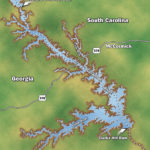
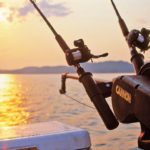
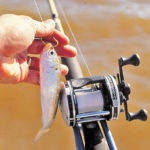
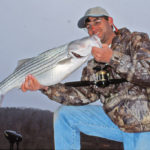
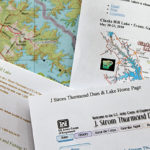


Be the first to comment